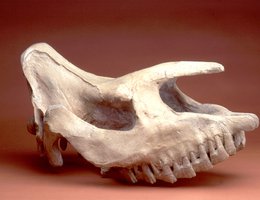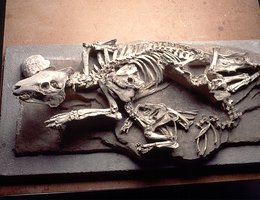

Imagine that you could be transported in a time machine to Nebraska 12 million years ago. You would walk out of your time machine into a very different world than the one you’re used to.

For one thing, you would be the only human being in the landscape. Humans had not yet evolved, and so animals dominated a landscape covered with sub-tropical grasses and patches of jungle.

The area that became Nebraska was much warmer 12 million years ago than it is now. Animals living during the Miocene geologic era — which lasted from 23 million years ago to 5 million years ago — most likely never saw snow. Twelve million years ago, its most dominant feature would have been a flat terrain covered by an ocean of grass, interrupted by shallow stream valleys and clumps of forest.

Animal life would have been present in stunning numbers and diversity. Dozens of hoofed species and grazing animals such as rhinos, giant camels, three-horned deer, four-tusked elephants, oreodonts, and horses lived on the American plains. Meat-eaters ranging in size from weasels to great lumbering bear dogs ranged over the landscape.

None of these animals could have known what you, the time traveler from the 21st century, knows — their world was about to change radically. Millions of years later, they would be part of one of the most amazing archaeological finds — a place called Ashfall.
To see the Ashfall Fossil Beds up-close take a virtual field trip: Ashfall Fossil Beds State Historical Park
You can learn more about Ashfall Fossil Beds and the animals found there at Paleo Sleuths/Ashfall Fossil Beds
If scientists could bring one of the animals back to life, which would you most like to see?
How has the geography and climate changed since your animal was last alive in Nebraska?
Why did these prehistoric Nebraska-area animals disappear?
Would your animal have to be placed in a zoo? If so, what special accommodations would the zoo keepers have to take to keep the animal healthy and to keep visitors and other animals safe?